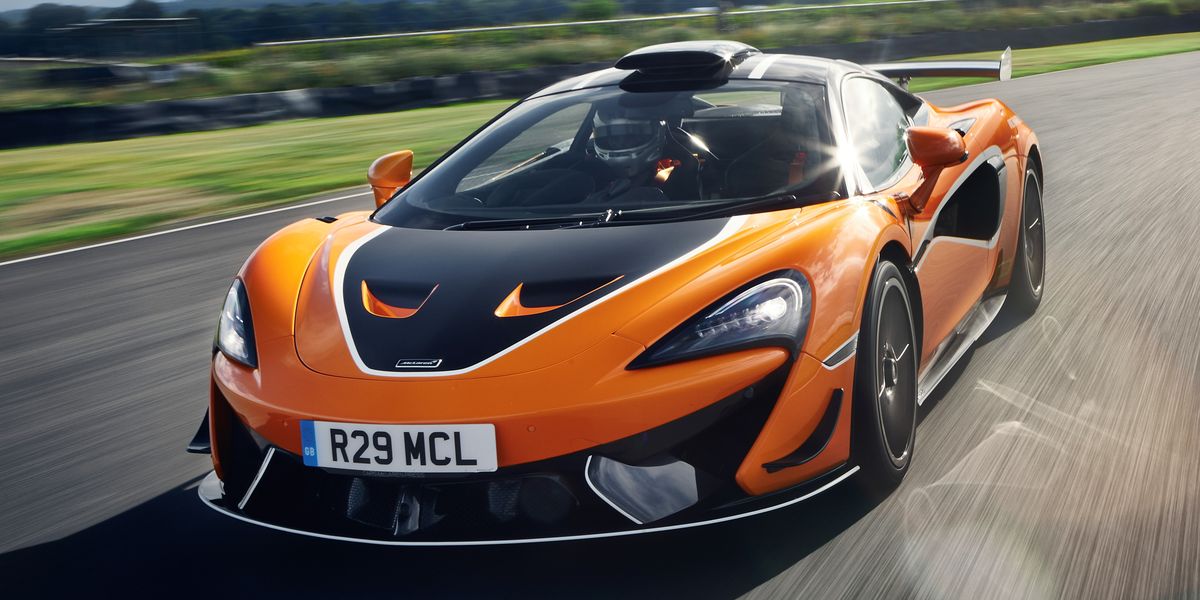
Automakers have long played on often tangential connections between race cars and their roadgoing equivalents, but the similarities are rarely more than skin deep. Not here. The McLaren 620R is very much the real deal, effectively the company’s GT4 competition-spec racer modified just enough to make it street legal. You can even order it wearing factory-applied sponsor graphics.
Those who have the stamina to keep pace with McLaren’s relentless launch schedule will remember the company already made a track-focused version of the Sports Series: the 600LT. The LT was great fun to fling around a race circuit, but it did so as an enthusiastic amateur. The 620R is a professional, playing in a different league and possibly even a different sport.
Not that this is achieved without cost. On road, the 620R is close to terrible in terms of noise and refinement. The cabin is filled with buzz and vibration at even modest speeds—the carpet and glovebox have been removed to save weight, and the residual soundproofing keeps out noise about as well as a screen door would. Beyond the lack of a roll cage, the view from the driver’s seat is essentially identical to that from the GT4’s.
Even with the 620R’s motorsport-grade adjustable suspension fully softened—something that needs to be done by clicking a valve on the dampers rather than with a button on the console—the ride is punishing. Sitting in the tight-fitting carbon-fiber bucket seat over rough tarmac gives an experience similar to one of the more vigorous massage functions in a luxury sedan. Buyers in the United States will get an integrated roof scoop air intake as standard, one that adds a Darth Vader-ish induction roar to the sensory overload. Full credit to whoever at McLaren had the keen sense of humor to specify the car we drove with the Bowers & Wilkins speaker upgrade, a $4410 option. Beyond 50 mph, a $20 set of headphones would be a better choice.
Of course, the 620R is hugely fast but not significantly more so than any of McLaren’s many other hugely fast options. It uses the same 3.8-liter V-8 base engine as the 570S but turned up to produce 612 horsepower—50 more than the lesser car. McLaren says that the 620R will be able to blast its way from rest to 60 mph in 2.8 seconds, from zero to 124 mph in 8.1 seconds, and on to a top speed (with the adjustable wing in its lowest downforce setting) of 200 mph. At everyday road speeds the 620R feels as if it has barely woken up, with grip levels from the standard Pirelli P Zero Trofeo R tires huge enough to preclude any sane attempts to discover their limits. Good thing it’s easy to outpace your fellow motorists, since the vast wing removes a significant amount of rearward visibility.
Yet once in its natural environment—a racetrack—the 620R becomes truly special. McLaren is offering the option of Pirelli slick tires on the same-size 19- and 20-inch rims as the street-legal Trofeo Rs. This means that, providing they have sent the race tires ahead, owners can drive to a favored circuit, swap their wheels, manually crank up the dampers, and then head straight out. (It is possible to specify the three-stage adaptive dampers of the regular Sports Series in place of the motorsport units, but that largely misses the point of the car.)
On track—Norfolk’s fast-but-technical Snetterton circuit—the now slick-shod 620R proves itself to be more of a surgical tool than a blunt weapon. It feels every bit as quick as its raw performance numbers suggest. It actually has considerably more power than the GT4 racer it is based on, which always delivers less than 500 horsepower to comply with GT regulations meant to balance the various manufacturers’ performance. The 620R’s iteration of McLaren’s 3.8-liter V-8 might be the most savage-sounding one so far, loud and animalistic even when experienced through the padding of a helmet. Changes from the dual-clutch transmission are ferociously fast, and the carbon-ceramic brake rotors prove tireless under even the hardest use.
The slick tires offer a relatively modest increase in peak performance over the Trofeo Rs (a 4-percent improvement on lateral G, according to McLaren), but they are much more tolerant of prolonged high-speed loadings. Grip felt predictably huge once they had been brought up to temperature, but it was soon clear that the 620R was less than tolerant of mistakes caused by enthusiastic over-driving. Getting on the gas too early in Snetterton’s tighter turns resulted in apexes missed by some embarrassingly wide margins, although traction was tremendous and the stability through faster corners impeccable. Even with the rear wing in its intermediate setting and producing less than its peak 408 pounds of downforce, the additional grip afforded by the aerodynamics was evident.
Despite its zany decals, the 620R is lacking the sense of fun we’ve found in less single-minded McLarens, a list that includes the well-rounded talents of the 600LT. It’s a car aimed at those who are deadly serious about going quickly, those who would rather have the fastest times at the track day rather than the most fun. But if you want to experience a McLaren race car in the real world without the need to put on flameproof coveralls or those cute little racing boots, this is a lot less expensive than a Senna. You’re more likely to see a Senna on the road, too, as Woking plans to build just 350 620Rs, 150 fewer examples than it plans for the Senna, making this Sport Series one of the rarest McLarens ever.
This content is created and maintained by a third party, and imported onto this page to help users provide their email addresses. You may be able to find more information about this and similar content at piano.io
